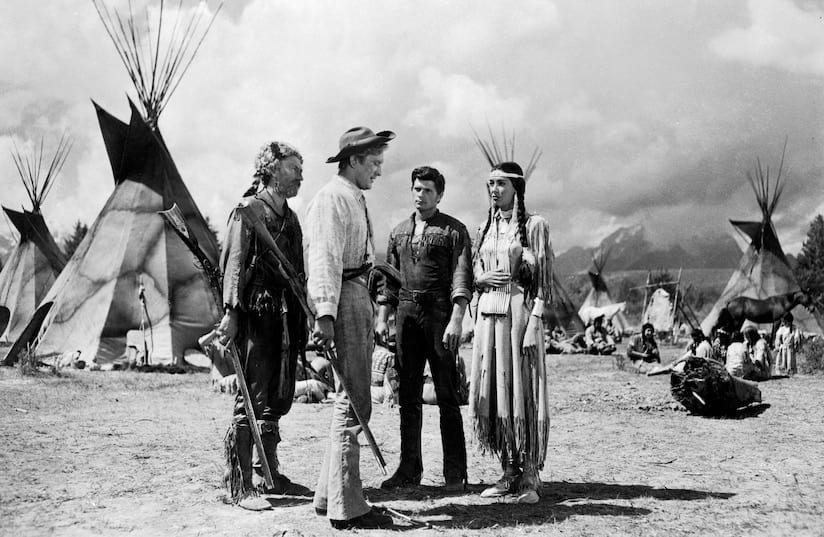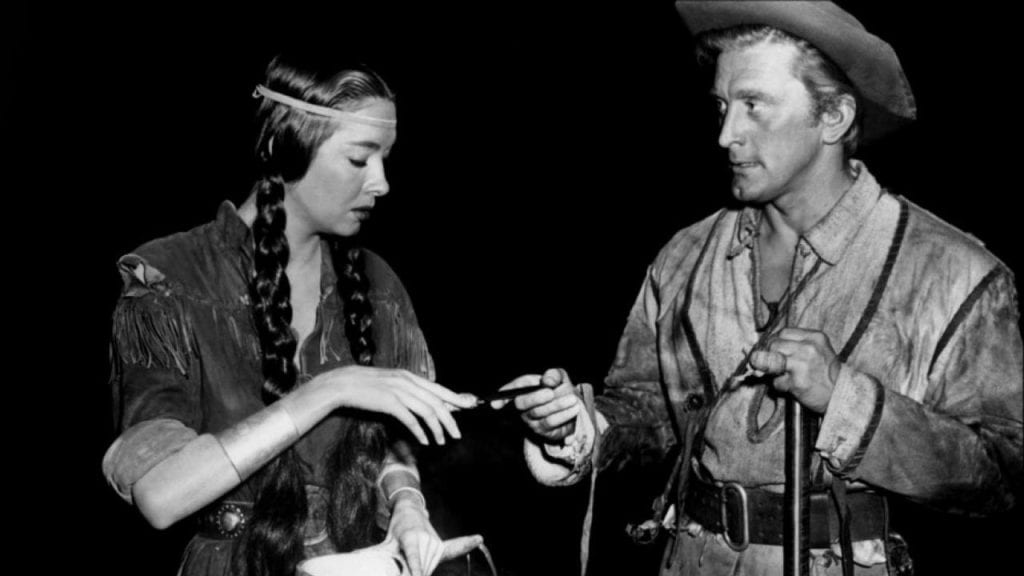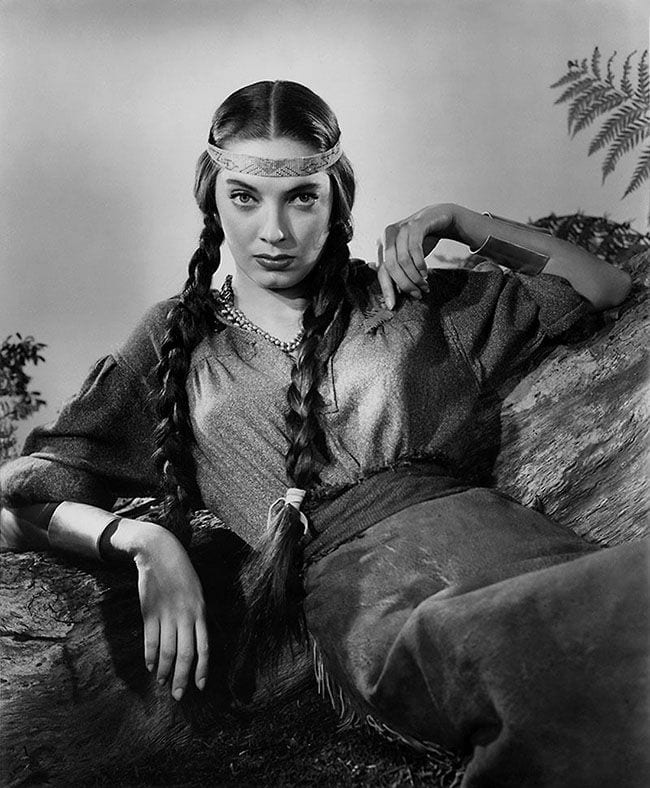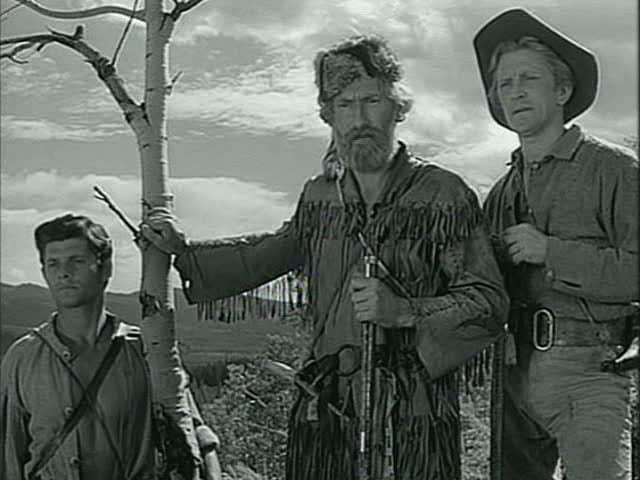
Though I regard Howard Hawks as one of the greatest American filmmakers and have written about the use of amorality or nihilism as a fundamental structuring principle in his comedies, the Hawks film that I might regard as his absolute greatest (on certain days, it’s my favorite) remains a very neglected title: his sublime and mysterious epic western The Big Sky, from 1952. Once, when I was seated early before a screening at a Chicago movie theater, I overheard two young guys talking about Hawks’s westerns. One of them was explaining to the other, “He made Red River in black-and-white, and then another western that no one really cares about, and then Rio Bravo, and then El Dorado…” I couldn’t help but feel a little bristled at overhearing this attitude since he was of course singling out my beloved The Big Sky as the ugly duckling of the group. Though in a way, he wasn’t wrong: there aren’t many people today who care about The Big Sky, perhaps because it’s a highly unique entry in his filmography. On the other hand, no one else in the world could have directed it besides Howard Hawks.
Part of what makes The Big Sky special as a Hawks film is, for me, tied to its use of environmental spaces. Many Hawks films, from Only Angels Have Wings (1939) to To Have and Have Not (1944) to Rio Bravo (1959), might be said to have a self-contained form: they present us with a series of waiting games which unfold within enclosed, clearly delineated sets, as the characters test each other’s moral boundaries using mysterious philosophical codes, thereby solidifying the bonds of the group as danger encroaches upon them. In contrast, The Big Sky has a vastly open form: it takes the shape of an extended saga up the Missouri River, which opens the film up to embody a childlike sense of awe and wonder at the natural world — a hushed and mysterious ecological ambience — that we don’t typically associate with the studio-bound Hawks, as well as a genial spirit of adventure.

The film follows a group of fur traders, led by Kirk Douglas and Dewey Martin. As Jonathan Rosenbaum writes, Douglas’s character, like many of the parts he played, is a resolute “individualistic hero” while Martin’s is an “ornery and quintessentially Hawksian team player.” Though their relationship gets off to a rocky start, their friendship becomes consecrated after Douglas punches Martin in the mouth during an argument between the two men. This detail already tells us that we are in the weirdly unbalanced and unstable Hawksian universe: whereas violence functions as a destructive force in most cinema, in Hawks’s, violence is often conceived of as a unifying force between men, a utopian means of constructing relationships. Later, once the two men arrive in a nearby town, they link up with Martin’s Uncle Zeb (Arthur Hunnicutt — one of the unsung heroes of American character acting) and a good many Frenchmen.
Before this ragtag party departs on the riverboat saga which will comprise most of the action of this adventure film, they solidify the social bonds of the group with a musical performance scene; a drunken rendition of “Whiskey, Leave Me Alone” in a barroom leads to a pleasurable intermingling of singing, drinking, and brawling which will permeate the group dynamics for the rest of the film. Hawks must have liked this tune because he reprised it ten years later for another, somewhat similar scene in Hatari! (1962), in which a group of men hang out and unwind after another day spent catching African animals for American zoos. All of these details lead the erudite viewer toward situating The Big Sky within the peculiarly ragged universe of Hawks’s filmography, despite the fact that it assumes a more epic form than most of his titles.

Another special aspect of The Big Sky is the presence of Indigenous American actor Elizabeth Coyote Threatt. Threatt plays Teal Eye, a Blackfoot woman who becomes involved in a love triangle with Douglas’s and Martin’s characters, and though she’s wonderful here, she never appeared in another film before or after. In contrast to the tough-talking frankness of the typical Hawksian woman (which one might associate with such actresses as Lauren Bacall or Jane Russell), Threatt gives a beautifully restrained performance here that lingers in one’s mind long after the film has ended. Additionally, she speaks all her dialogue in its original Native language. Jim Jarmusch, whose post-classical acid western Dead Man (1995) remains the only western I know which allows its Indigenous character (Gary Farmer) to speak in a Native tongue without providing English subtitles, has cited The Big Sky as a particular favorite of his. This somewhat progressive aspect of the film’s treatment of Native Americans serves as a welcome rejoinder to the habitual racism evinced in many westerns of the period. Though there was briefly a cycle of westerns made in the early ‘50s which exhibited a more sympathetic attitude toward the plight of Indigenous peoples — the most famous example being Delmer Daves’s Broken Arrow (1950) — few seem as sensitive to these issues as The Big Sky does.
Elizabeth Coyote Threatt was born in 1926 in Kershaw, South Carolina; her father, William Threatt, was a Cherokee man who worked for the US army. After spending part of her childhood in Florida, Threatt struck out on her own and moved to New York City, which she was drawn to because she, in her own words, “wanted to learn about people fast.” Thanks in part to a suggestion from a friend of hers, she decided to pursue a career in modeling and eventually landed a post at the John Powers agency. She quickly became one of the most sought-after models in the country, earning $900 a week. It was through her modeling career that Threatt came to be noticed by Howard Hawks, whom she briefly dated in 1950.
It was Hawks’s idea to cast Threatt in the role of Teal Eye, and though she had no prior acting experience, even in amateur productions, she accepted the role and acquitted herself quite well on the project. Her character gets a great deal of screen time, and though the film ultimately conceives her character as a kind of conduit for the fur traders to be able to trade with the Blackfoot tribe, her part is more complex than most Indigenous women characters seen on screen in that period, or any other period for that matter. After making The Big Sky, RKO dropped Threatt’s contract, reportedly so that they could sign Dewey Martin on as a contract player instead. Unfortunately, no other studio signed Threatt after this, and she returned to New York to continue modeling. After marrying her third husband in 1956, she retired from modeling and lived a more private life until her death in 1993.

To my mind, the progressive and multicultural strain of The Big Sky should be seen as being in keeping with its other utopian and ecological aspects. It is very much a film in which the characters leave settler civilization behind, moving instead toward a freer world of exciting, sensual discovery, making up their own sprawling, organic community as they go along. Watching the film, with its vast spaces and its mysterious environmental landscapes, has the strange effect of making me feel like a ten-year-old again, thrilled by the joy of discovery. So while The Big Sky is very much of a piece with Hawks’s filmography in its social, collectivist aspects, it’s also quite singular in this regard. In short, it’s a film that reminds us how grand and how beautiful the cinema can be at its absolute best.

Join IU Cinema as we present Native Women in Cinema, a series which seeks to replace the erasure women and queer Natives have suffered in film with three recent and powerful movies: Drunktown’s Finest on April 14, and Pure Grit and Gone with the River on April 15. This series is supported through IU Cinema’s Creative Collaborations program.

Jack Miller enjoys the films of Howard Hawks, Jacques Tourneur and John Ford. He graduated from Indiana University with a BA in English, and currently resides in Chicago. He also enjoys listening to country and disco music.